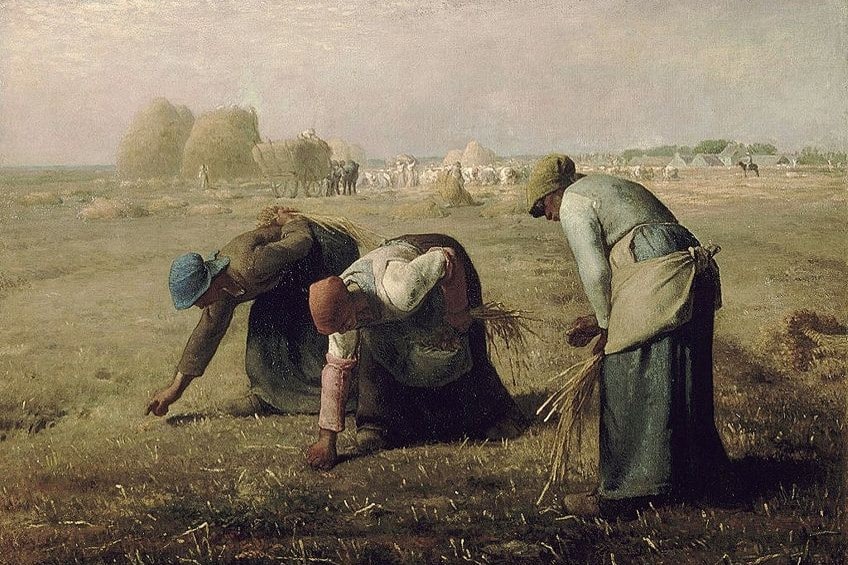Realism Art – Exploring the Style of the Realism Art Movement
Mankind’s ability to replicate what we observe has evolved dramatically throughout history. During the Renaissance period, artists perfected techniques that made their art realistic. However, Realism art is about so much more than simply producing realistic art. Carry on reading to learn about what the Realism art movement was really about.
Contents
What Is Realism in Art?
The Oxford dictionary defines realism as, “a way of seeing, accepting, and dealing with situations as they are without being influenced by your emotions or false hopes.” The Realism art definition is similar and applies to depicting subject matter as it is, not how the artist wants it to be. Many people think that Realism in art is simply about making something appear realistic.
Trying to achieve an accurate depiction of one’s subject matter is one aspect of Realist art, however, it is also a characteristic of Naturalism.
So, then what is the difference between Naturalism and Realism in art? Like Realism art, Naturalism in art is when artists try to paint something true to life. It was utilized by artists of the Classical period, the Renaissance, the Romantic era, and many more. Realism artists use the same techniques as Naturalists; however, their creative intentions are different.
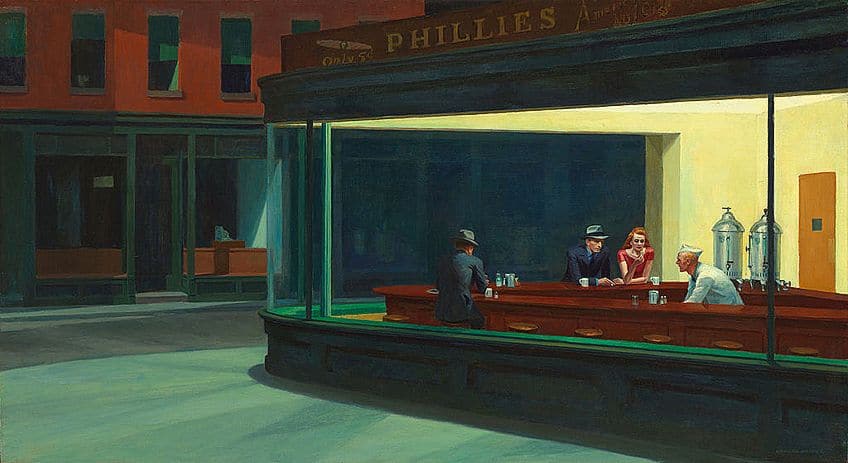
The Realism art movement began in France in the late 1800s shortly after the February Revolution of 1848. During this time, there was a great deal of violence and suffering in France caused by the removal of King Louis Philippe I and the induction of the Second Republic.
Thus, artists grew tired of the idyllic notions of Romanticism and wanted to realistically depict the everyday struggle of the common people.
Therefore, the main thing that distinguishes Realism in art from Naturalism is that it is about what is being painted. Realism is motivated by political and humanitarian ideology. Naturalism on the other hand is more about how something is painted, making its subject matter and intentions irrelevant.
A Brief History of Realism Art
In this section, we shall take a brief look at the origins of Realism art. From its start in France to the way it spread across Europe as well as the various events that had an impact on it. After reading this, you will have an understanding of why the Realism art movement was so particular to this period.
The Origins of the Realism Art Movement
As mentioned above the Realism art movement began in France in the 19th century. During this time, the country was in a state of political unrest. During the reign of Louis Philippe I, a small group of the population (made up of merchants) became very wealthy. However, the vast majority of the people, made up of middle and lower-class citizens, were left poor and with no say in politics.
Before Realism painting, it was rare for everyday people in France to be included in the art world. Unlike other countries in which genre painting had become popular, France was still dominated by academic art and portraiture for the wealthy.
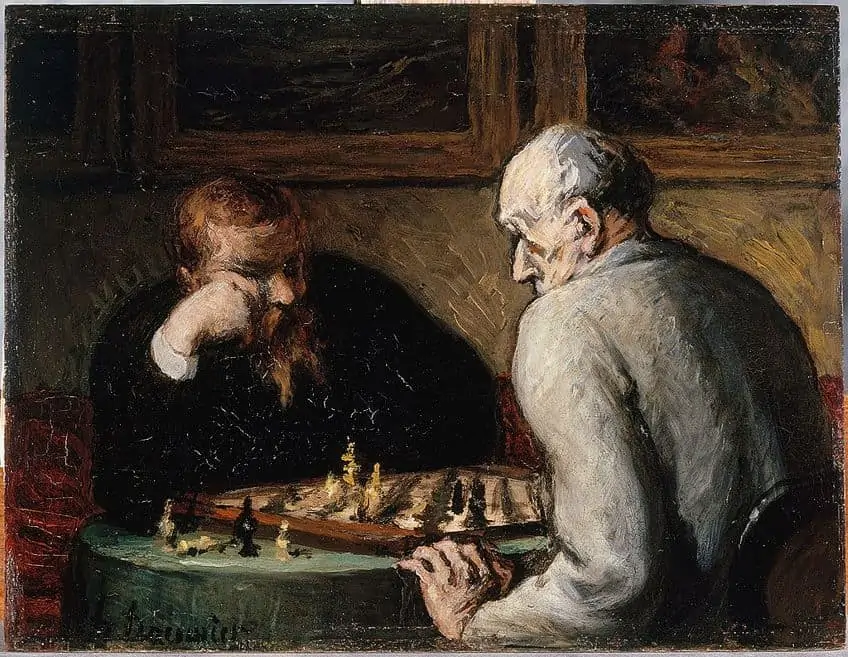
This meant that the middle and lower classes were not interested in art nor were they present in it. The Realism art movement changed this by making these classes the focal point of Realism art. What was also unique was that they were not glorified or romanticized. They were simply shown exactly as they were in reality with no sentimentality.
One of the most influential French Realism artists was Gustave Courbet. He exhibited some of the first works of Realist art at the Paris Salons of 1849 and 1850.
The artworks he exhibited A Burial at Ornans (1849 – 1850) and The Stone Breakers (1849) will forever remain Realism artifacts. In 1861, Courbet released his own Realist Manifesto to the public in which he stated, “Imagination in art consists in knowing how to find the most complete expression of an existing thing, but never in inventing or creating that thing itself “, which has also become a Realism artifact.
Realism Art in Britain
The conditions for common people in Britain were just as dire as in France. By this time, Britain had entered its second Industrial Revolution in which automobiles began being manufactured along with improvements in electricity. Unfortunately, it was not until much later that these innovations would benefit the poor and the working class.
The situation for the majority of the population was dismal. Many moved to the city to find work, which led to overcrowding and poor sanitation.
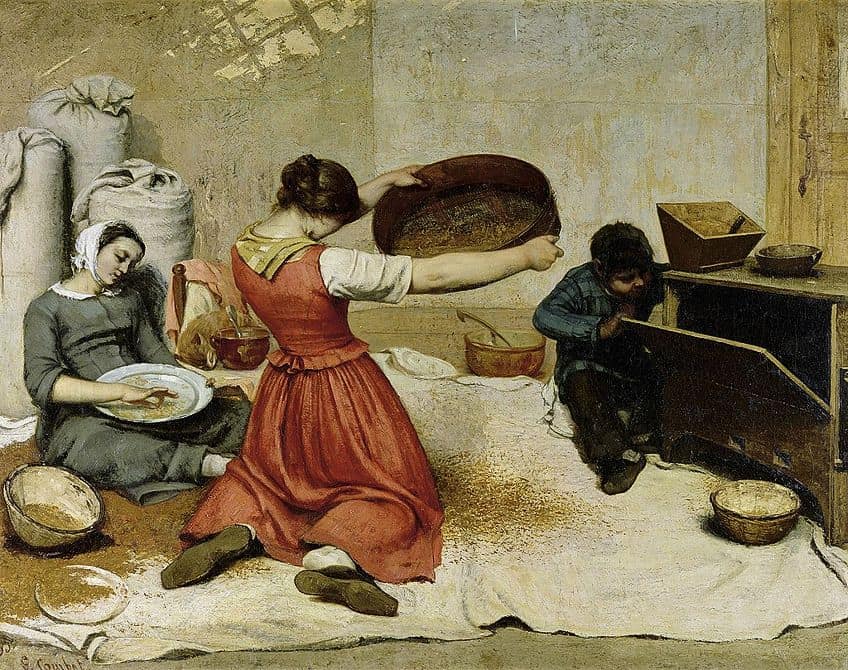
As a result, diseases like tuberculosis and cholera claimed countless lives leaving many children orphaned. These children would then be sent to workhouses and used as child labor. Working conditions for children as well as adults were inhumane with long hours and poor pay. However, little could be done by these powerless people to change their situation.
Many creatives were influenced by the hardship surrounding them. In literature, authors such as Charles Dickens spoke out about the difficulties of the working class.
The words of Karl Marx in his Communist Manifesto (1848) had also spread around Europe and many felt inspired by his call for the emancipation working class. British artists such as Sir Samuel Luke Fildes followed suit from the French and began creating Realism paintings to draw attention to the plight of the common people.
Realism Art in Russia
The Realism art movement became popular in Russia around 1860. In 1863, a group of Realism artists made up of students from the Imperial Academy of Arts formed to protest the conservative and limiting nature of the Academy. They called themselves the Peredvizhniki (or “Wanderers” in English) and their main aim was to do away with the elitism that surrounded art.
The Peredvizhniki painted the peasants of Russia in order to showcase their political views.
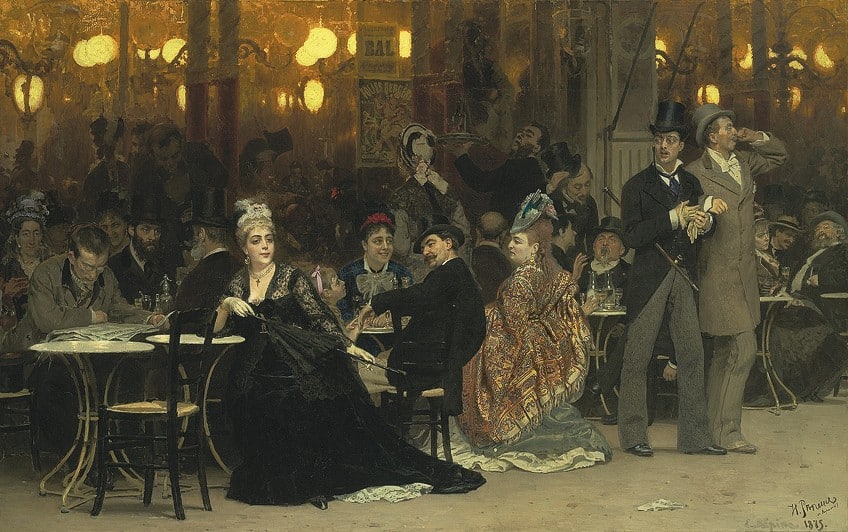
There was huge inequality between the rich and poor at the time, with serfdom only having been done away with in 1861. Although they adhered to the Realism art definition, there was still a touch of Romanticism in how sentimentally they portrayed the common people. They portrayed their everyday struggles but made it clear they believed this work to be honorable.
In order to make art accessible to everyone regardless of their status, the Peredvizhniki held a total of 48 art exhibitions between 1871 and 1923.
Within the group were artists such as Ilya Repin, Ivan Shishkin, and Konstantin Savitsky who are now widely celebrated. They traveled all over Russia displaying their artworks to rich and poor alike. The peasantry, who had previously thought of art as reserved for the wealthy, developed a new appreciation for art. They were no longer alienated as they saw scenes familiar to them depicted in a dignified manner.
Famous Realism Art
Realism painting began in France but soon spread to the rest of Europe as well as the United States. As each country faced its unique reality there is a fair amount of variety within the Realism art movement. What unites these artists is their desire to show ordinary people in everyday settings as truthfully as possible.
Honoré Daumier
| Date of Birth | 26 February 1808 |
| Date of Death | 10 February 1879 |
| Place of Birth | Marseille, France |
| Nationality | French |
Honoré-Victorin Daumier was born in Marseille, France in 1808. He died in Valmondois, France in 1879 at the age of 70 years old. During his lifetime Daumier made a name for himself through his political illustrations as well as the paintings and sculptures he created later in life. He was a republican democrat who publically expressed his political views, even during times when the press was heavily censored.
At the beginning of his career, Daumier created illustrations for La Silhouette a left-wing newspaper that ran from 1829 until it was forced to close in 1831.
La Silhouette openly criticized the church, monarchy, politicians, and the bourgeoisie through satirical cartoons, which resulted in crippling fines. It was due to these fines that it eventually became bankrupt and was forced to shut down. However, by this time Daumier had already made a name for himself and thus was asked to join the staff of La Caricature, another political newspaper.
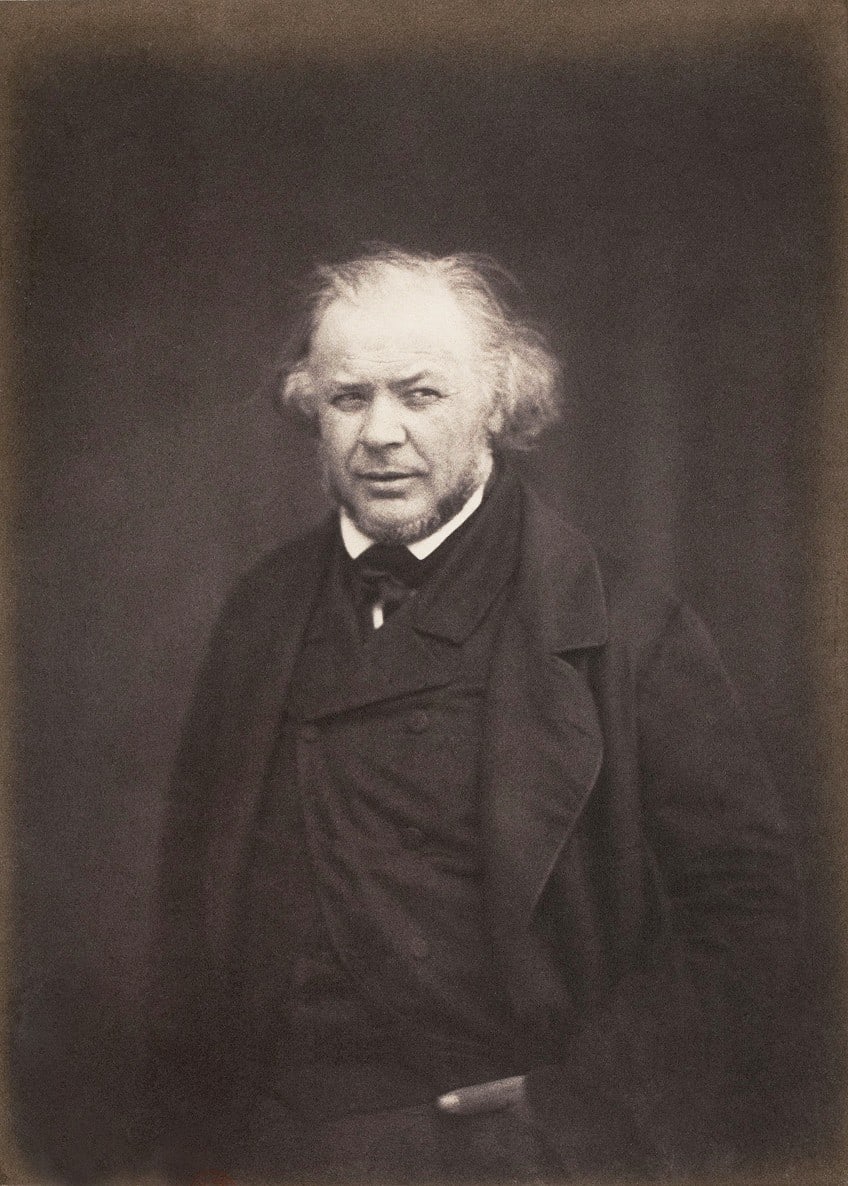
The team was made up of several reputable illustrators as well as the famous novelist Honoré de Balzac, who was its editor. La Caricature was even more outspoken than La Silhouette. Whilst working there, Daumier published an illustration called Gargantua (1831), which depicted King Louis Philippe guzzling taxes from the poor and excreting them as riches for the church and bourgeoise classes.
In 1832, Daumier served six months in prison and was forced to pay hefty fines because of Gargantua.
Rue Transnonain (1834)
| Date Painted | 1834 |
| Medium | Lithograph |
| Dimensions (cm) | 46.5 x 34 |
| Where It Is Currently Housed | Prints owned by several museums around the world |
| What It Is Worth | $2.6 million |
The first years of King Louis Philippe’s reign were full of worker riots as a result of the poor living conditions for common people at this time. In April 1834, workers protesting in Lyon were violently suppressed by state soldiers. Following this, workers in Paris began rioting to express their disapproval of the state’s cruelty. During this riot, a captain of the infantry was shot from the roof of a building on Transnonain street.
Later that evening, soldiers entered the building (which was an apartment block) and killed all of the residents inside including women, children, the elderly, and the disabled.
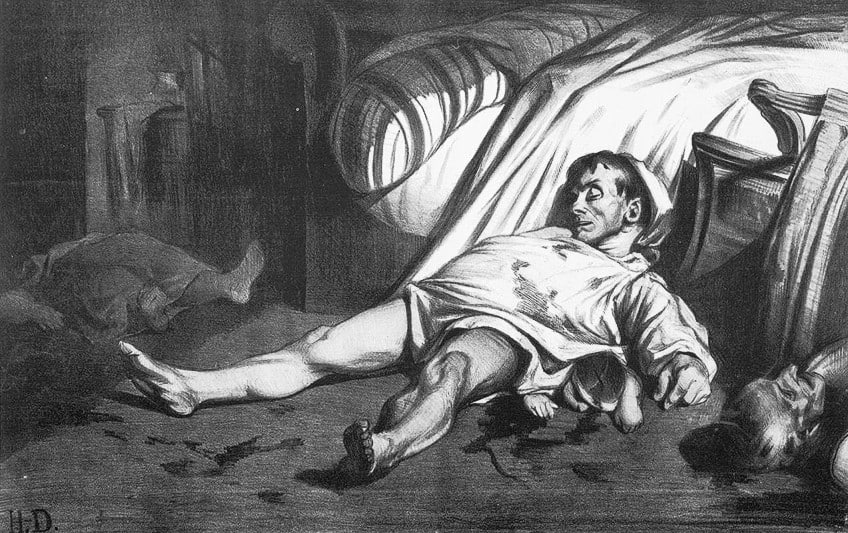
Many of these people were found murdered in their beds, which caused a mass outcry at the brutality of the incident. Daumier’s Rue Transnonian (1834) depicted the massacre in a Realist fashion. He did not show the action of the massacre but rather the aftermath in all its morbidity.
The illustration is set in a bedroom to show how vulnerable those who were murdered were.
A man in night clothes lies dead, underneath him we see the small hands and head of a child who was also killed. An elderly man and a woman lying dead in the background show that the state soldiers were merciless and took many innocent lives. Daumier’s illustration is a heart-wrenching work of Realist art, which shows just one of the countless atrocities that happened in France during this time.
Jean-François Millet
| Date of Birth | 4 October 1814 |
| Date of Death | 20 January 1875 |
| Place of Birth | La Hague, France |
| Nationality | French |
Jean-François Millet was born in 1814 in Normandy, France. He received a basic education from the priests within his village, however, he spent the majority of his time helping his father work their land to put food on the table. At the age of 19 years old, he began doing an apprenticeship with an artist in a nearby town.
By the age of 23, Millet had moved to Paris in order to study at the École des Beaux-Arts. Over the next few years, Millet moved between Paris and the French countryside many times. He needed to be in the city for his career to take off, however, he consistently longed for rural life.
During the late 1840s, Millet began to make a name for himself as an artist. This period in his career also marked the start of his Realist art. Although he continued to paint the peasantry as before, Millet stopped romanticizing rural life and instead began showing the reality and hardships that peasants faced.
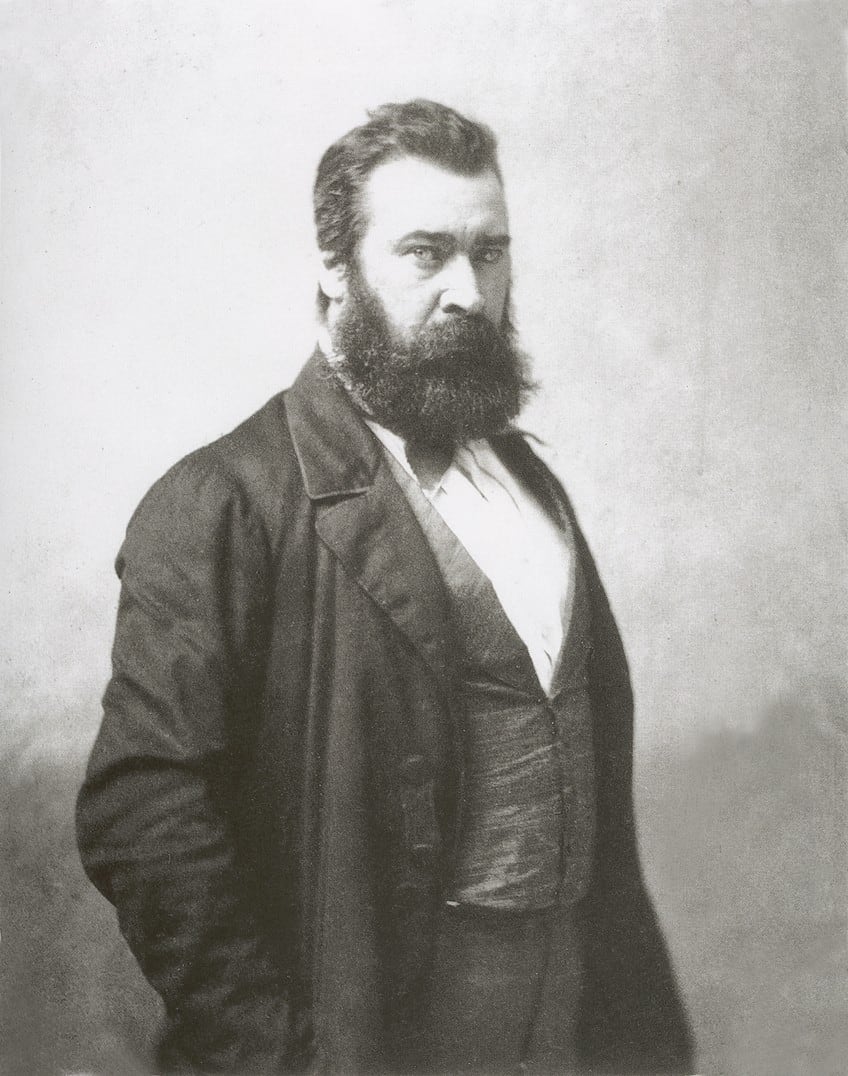
At first, many art critics were opposed to Millet’s Realism paintings, believing them to be anti- bourgeoise attempts at promoting Socialism. However, they eventually realized that Millet was more concerned with showing the nobility of the peasantry than trying to cause a rebellion. His works began to soar in popularity and in 1866 he was awarded a Legion of Honor for his Realism art. Four years later, he was also elected to be one of the judges for the Paris Salon.
The legacy that Millet left behind was highly impactful in the world of art. He was one of the founding members of the Barbizon school, which was a group of Realist artists.
The artists who made up this group such as Charles- François Daubigny, Théodore Rousseau, and Jean-Baptiste-Camille Corot are now some of the most celebrated artists in French history. In later years, famous artists such as Vincent van Gogh and Salvador Dalí often spoke of their appreciation for Millet’s work.
The Gleaners (1857)
| Date Painted | 1857 |
| Medium | Oil on canvas |
| Dimensions (cm) | 112 x 84 |
| Where It Is Currently Housed | Musée d’Orsay, Paris, France |
| What It Is Worth | Sold for $60,000 in 1889 before becoming state property |
Gleaning is something Millet studied meticulously before creating The Gleaners (1857). The practice of gleaning goes back thousands of years. It is when the poor search farmer’s fields after a harvest to try to find any crops that have been left behind or discarded. In many Western countries, this was seen as a legal right of the poor and farmers could not stop them.
In Millet’s The Gleaners, we see three women who are hunched over searching the ground for crops.
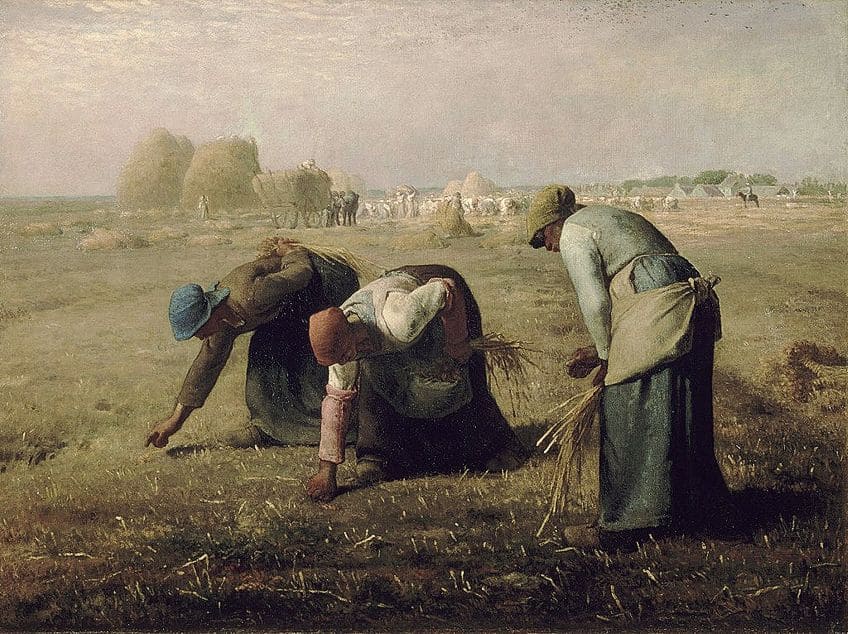
The process is strenuous; however, the women work as they must to provide for their families. In most cases, gleaning is a sign of abject poverty. Millet does an amazing job of capturing the severity of these women’s situations. He manages to depict the nobility in such work without being overly sentimental.
His use of strong contrast been light and shadow helps to convey a sense of sad resilience that is simultaneously heartbreaking and inspiring.
In 1857, Millet exhibited The Gleaners at the Paris Salon. At first, the audience was highly critical of the artwork believing it to be a Socialist call to arms. However, after some time they began to appreciate the beauty of Millet’s work and open their eyes to the fact that this level of poverty was experienced by the majority of French people at this time.
Gustave Courbet
| Date of Birth | 10 June 1819 |
| Date of Death | 31 December 1877 |
| Place of Birth | Ornans, France |
| Nationality | French |
Jean Désiré Gustave Courbet was born in 1819 in Ornans, France. He felt a deep connection with his hometown and often featured it in his Realism paintings. Courbet was a figurehead in the Realism art movement as he was one of the first artists to denounce Romanticism (the art movement popular at the time) in favor of painting only what he could see as it was in reality.
At the beginning of his career, Courbet trifled with Romanticism painting, however, it was short-lived. After visiting Belgium and the Netherlands (where genre painting was very popular) from 1846 to 1847 he was certain that he should only paint real life.
In 1855, Courbet wrote an open letter to the press outlining what he called the Realist Manifesto. This manifesto, as well as Courbet’s rebellious spirit, inspired many later artists including the celebrated Claude Monet and Paul Cézanne. Courbet was a controversial person throughout his career. He did not express his political beliefs directly through his art; however, he used the fame he achieved as an artist to spread his socialist ideology.

In 1870, Courbet refused a Legion of Honor award from Napoleon III. Whilst the French government was enraged by this incident, it solidified Courbet as a man of the people in the minds of the common folk. In 1871, he spent six months in jail due to his ties with the Paris Commune, which was a rebel government that took advantage of the chaos of the Franco-Prussian War and seized Paris for around three months in that same year.
It is for this same reason that he was forced to flee to Switzerland in 1873 to avoid paying for the destruction of the Vendôme Column, for which he was blamed for inciting.
A Burial at Ornans (1849 – 1850)
| Date Painted | 1849 – 1850 |
| Medium | Oil on canvas |
| Dimensions (cm) | 660 x 315 |
| Where It Is Currently Housed | Musée d’Orsay, Paris, France |
| What It Is Worth | Uncertain |
A Burial at Ornans (1849 – 1850) is one of the many paintings Courbet created of his birthplace. In fact, the painting depicts the funeral of Courbet’s relative and the figures were actual guests who attended the event. Courbet was a strong believer that only artists from a specific time could capture the period’s true essence. Therefore, he felt it was his duty to document everyday scenes from Ornans and the surrounding area.
In 1851, Courbet exhibited A Burial at Ornans at the Paris Salon for the first time. The painting stood out for a number of reasons.
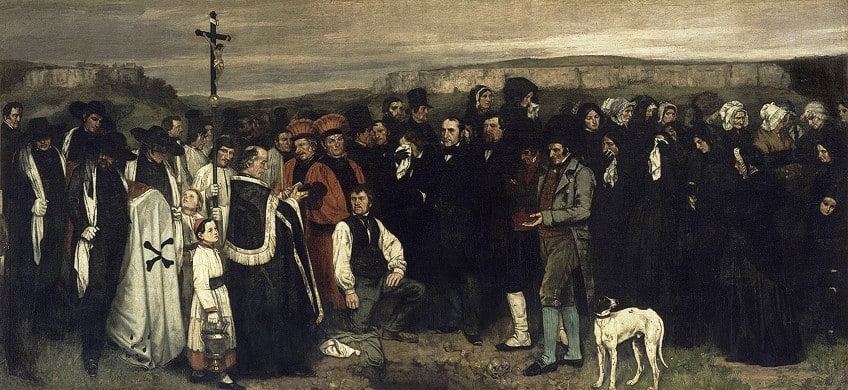
Firstly, it was painted on a colossal scale, which was reserved for religious and historical paintings at the time. Many critics felt that to paint an ordinary scene on this scale was pure vanity and insolence. Burial at Ornans was also one of the first Realist artworks to be displayed to the public.
Unaccustomed to this new art style, many accused Courbet of intentionally painting something unattractive.
However, it was not long before art enthusiasts and critics alike began to appreciate the raw honesty of Courbet’s Realism art. Soon, many artists began producing similar works and the Realism art movement increased in popularity. Courbet himself referred to Burial at Ornans as, “the burial of Romanticism”.
Thomas Eakins
| Date of Birth | 25 July 1844 |
| Date of Death | 25 June 1916 |
| Place of Birth | Philadelphia, United States of America |
| Nationality | American |
Thomas Cowperthwait Eakins was born in Philadelphia in the United States of America in 1844. Eakins exhibited artistic talent from a young as well as a love for sports (which he often depicted later in his artwork). When he was 22 years old, he moved to Paris, France to study at the École des Beaux-Arts.
It was here that he developed a strong interest in Realist painting, which he pursued for the remainder of his career.
A few years after he returned to America in 1870, Eakins began working as an art professor at the Pennsylvania Academy. He was unique in his teaching methods stating, “A teacher can do very little for a pupil and should only be thankful if they don’t hinder him…” Whilst Eakins tried to minimally instruct his pupils – he made sure to expose them to as much as possible. He was highly invested in the study of anatomy and often included mathematics and biology in his teachings. Controversially, Eakins allowed his female students to paint male nudes (which was prohibited at the time) albeit with covered genitalia.

A culmination of scandals surrounding his unorthodox teaching methods, as well as reportedly inappropriate behavior towards students meant that Eakins’ position in the Academy was always precarious. In 1886, he was fired for allowing female students to paint male models that were fully nude. His dismissal caused humiliation for him and his family. However, many of his students stood by him and formed the Art Students League of Philadelphia to continue being taught by him.
Eakins did not have a very successful art career for the majority of his life and often struggled to sell his paintings. In his final years, his Realism art began to slowly grow in popularity.
However, it was not until after he died in 1916 that his paintings were worth something of value. This was predominately thanks to his wife Susan Hannah Macdowell, who worked tirelessly to repair his reputation and promote his paintings. In the current day, Eakins is considered to be one of the most important Realist artists in American history.
The Gross Clinic (1875)
| Date Painted | 1875 |
| Medium | Oil on canvas |
| Dimensions (cm) | 240 x 200 |
| Where It Is Currently Housed | Philadelphia Museum of Art, Philadelphia, United States |
| What It Is Worth | $68 million |
It was a trademark of Eakins’ to paint portraits of people whilst they went about their daily life. He believed that this was the only way that one could capture their true essence. The Gross Clinic (1875) was no exception and depicts Dr. Samuel D. Gross overseeing an operation that is being conducted by his students at Jefferson Medical College.
Upon being exhibited, The Gross Clinic received widespread criticism for being too realistic.

Many felt it unnecessary to paint such a gory scene in so much detail. The painting would not have even sold had it not eventually been bought by Jefferson Medical College for only $200. Now, however, the painting is highly praised as being a window into the history of medicine and its evolution.
Due to his obsession with nude figures (male and female alike), Eakins’ sexuality has become a topic of heated debate.
The Gross Clinic is one of his paintings believed to contain subtle homoerotic undertones due to the clearly pronounced male buttocks in the center of its compositions. Many believe that Eakins was secretly engaged in a homosexual relationship with Samuel Murray, his student, and lifelong friend.
Ilya Repin
| Date of Birth | 5 August 1844 |
| Date of Death | 29 September 1930 |
| Place of Birth | Chuhuiv, Ukraine |
| Nationality | Russian |
Ilya Yefimovich Repin was born in 1873 in Chuguev, Ukraine, although during this time Chuguev was part of Russian territory. Repin came from a middle-class family in which his mother had ties to nobility. However, Repin considered himself to be a peasant and a man of the people. He began training as an artist’s apprentice at the age of 13 and continued to pursue a career in art for the remainder of his life. In 1864, after many failed attempts, he was accepted to study at the Imperial Academy of Art in St. Petersburg.
At the beginning of his career, Repin mainly painted portraits and other traditional themes such as religious allegories and scenes from mythology. However, from the 1870s, there is an evident transition toward Realism in his artworks.
Repin was a patriotic Russian who vocally expressed his anti-Tsarist beliefs. He aimed to elevate the status of the Russian peasantry through his paintings and dreamed that one day Russia would be led by its people. In 1877, he joined the Peredvizhniki a group of artists who aimed to introduce the poor people of Russia to the world of art (a world which they had long been excluded from).

In January 1905, imperial soldiers opened fire on workers who were peacefully protesting outside the Winter Palace. Fourteen people were killed earning the event the name Bloody Sunday and resulting in the Revolution of 1905. Repin was very active in the anti-Tsarist protests that proceeded. He also created many sketches which recorded the violence enacted on protestors by the state. In 1917, Russia experienced another two revolutions, the first of which is known as the February Revolution (although according to the Gregorian calendar this would have happened in March).
During the February Revolution, the Russian monarchy was removed from power and assassinated. At first, Repin welcomed the changes that the revolution brought about.
However, he soon realized the corruption within the Bolshevik government. It was because of this that he refused to return to Russia even at the request of Joseph Stalin himself. He lived out the rest of his days in Finland, where he eventually died in 1930. His home in Kuokkala, renamed Repino in 1948 after the artist himself, is now a UNESCO Heritage site.
Barge Haulers on the Volga (1870 – 1873)
| Date Painted | 1870 – 1873 |
| Medium | Oil on canvas |
| Dimensions (cm) | 281 x 131.5 |
| Where It Is Currently Housed | State Russian Museum, St. Petersburg, Russia |
| What It Is Worth | Uncertain |
In 1870, Repin and some of his peers went on a painting expedition to the Volga River. Here he made many sketches of the fishermen and peasantry from the surrounding area. After viewing some of Repin’s sketches, Grand Duke Alexander Alexandrovich commissioned a fully realized painting of epic proportions.
The Barge Haulers on the Volga (1870 – 1873) is one of the most famous paintings in Russian art history. Repin clearly depicts the hardships experienced by the peasantry and working classes during this period in Russian history.
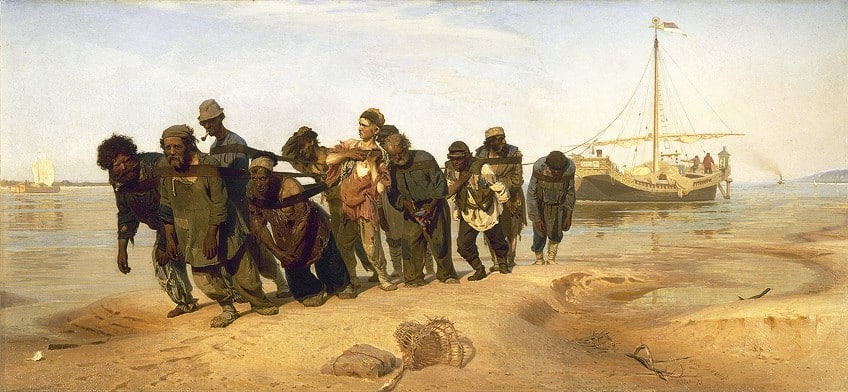
His Realist paintings do not glamourize their plight, however, they do express a glimmer of hope as can be seen by the young man in The Barge Haulers on the Volga who resists his cruel task. The Barge Haulers on the Volga is what made Repin an internationally famous Realist artist and allowed him to travel through Europe displaying his artworks in Austria, Italy, and France.
The Realism art movement, which began in the mid-19th century was about so much more than simply replicating everyday objects. It was deeply rooted in political beliefs and the everyday struggle of the people at its time. Although only five Realist artists were discussed here, there are many more who were just as impactful. So, make sure to explore further if you enjoyed reading this article.
Take a look at our Realism in art webstory here!
Frequently Asked Questions
What Is a Realism Artifact?
Realist artworks, which are considered to be critical contributions to the art movement, are now known as artifacts of Realism. These would include notable paintings by Realist artists such as Honoré Daumier, Jean-François Millet, Gustave Courbet, and many more.
What Is Realism in Art?
Realism in art applies specifically to the realistic depiction of everyday scenarios. The Realism art movement began in France in the 1850s as a reactionary movement to Romanticism. Artists such as Gustave Courbet were inspired to show the reality of life as a common person during that time. For this reason, Realism was often linked to the political left-wing and Socialist movements, making it unpopular amongst the bourgeoisie. Artists in other parts of the world, such as Russia and the United States, took inspiration from the French and began depicting situations unique to their own countries.
What Influenced Realism Art?
Realism art emerged as a rebellion against the Romantic art movement. It wanted to remove sentimentality and grandeur and show the harsh realities of life. The Realism art movement began in France in the 1850s during a time of political unrest. At this time, King Louis Philippe I was in power, however, the majority of people wanted France to do away with its monarchy completely and become a democracy. Therefore, as Realist art focuses on the common people, it often contains left-wing political undertones.
Jordan Anthony is a Cape Town-based film photographer, curator, and arts writer. She holds a Bachelor of Art in Fine Arts from the University of the Witwatersrand, Johannesburg, where she explored themes like healing, identity, dreams, and intuitive creation in her Contemporary art practice. Jordan has collaborated with various local art institutions, including the KZNSA Gallery in Durban, the Turbine Art Fair, and the Wits Art Museum. Her photography focuses on abstract color manipulations, portraiture, candid shots, and urban landscapes. She’s intrigued by philosophy, memory, and esotericism, drawing inspiration from Surrealism, Fluxus, and ancient civilizations, as well as childhood influences and found objects. Jordan is working for artfilemagazine since 2022 and writes blog posts about art history and photography.
Learn more about Jordan Anthony and about us.
Cite this Article
Jordan, Anthony, “Realism Art – Exploring the Style of the Realism Art Movement.” artfilemagazine – Your Online Art Source. October 13, 2022. URL: https://artfilemagazine.com/realism-art/
Anthony, J. (2022, 13 October). Realism Art – Exploring the Style of the Realism Art Movement. artfilemagazine – Your Online Art Source. https://artfilemagazine.com/realism-art/
Anthony, Jordan. “Realism Art – Exploring the Style of the Realism Art Movement.” artfilemagazine – Your Online Art Source, October 13, 2022. https://artfilemagazine.com/realism-art/.


